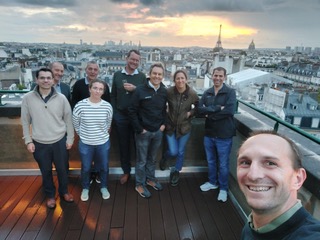09/2024 Crossing latest developments in optics and open questions in neurobiology

More info soon on Experimental neuroscience, as we know it today, is largely building on techniques that were originally developed in very diverse communities including non-linear optics, photochemistry, or light-shaping techniques. What if we bring together leading actors in contemporary topics with molecular and cellular neurobiologists to offer a friendly, open-minded and curiosity-driven emulsion of ideas? OMNI-TOOLS aims at bringing together disjunct communities from very timely, fundamental quantum optics to spatial genomics. The idea is to see if contemporary, latest developments in optics can create an immediate impact in (neuro-) biological applications. We have five years to find out.
On Monday 23/9, the SPPIN proudly hosted the kick-off meeting of the CNRS IRN “OMNI-TOOLS” international research network.
OMNI-TOOL is co-funded by CNRS Biology and CNRS Physics in collaboration with our israeli partner universities.
23/09/2024 : List of financed projects of the first OMNI-TOOLS project call
- Omni-slide: A common language for fluorescence microscopies. PIs: Adi Salomon (BIU) and Martin OHEIM (CNRS)
- Uncovering functional roles of Fañanas cells of the cerebellum through genomic strategies and expansion microscopy. PIs: Shahar ALON (BIU) and Martin OHEIM (SPPIN, CNRS)
- Second-order parametric cascading in PPKTP quasi-periodic photonic crystals for spontaneous triple photons generation (TPG-QPPKTP). PIs: Benoît Boulanger, Véronique Boutou (Institut Néel, CNRS) , Ady Arie (TAU). Students: Julien Bertrand ( Institut Néel, CNRS) , Inbar Hurvitz (TAU).
- Fluctuation-based aberration correction in all-optical photoacoustic imaging. PIs: Ori Katz (HUJ) and Thomas Chaigne (Institut Fresnel, CNRS)
- 5 – Advancing computational scattering compensation of fluorescence microscopy through reference-less wavefront-sensing. PIs: Marc Guillon (SPPIN, CNRS) and Ori Katz (HUJ)
- Fluorescence noise analysis: a novel tool for identifying environmental stresses in plants. PIs: Anja Krieger-Liszkay (I2BC, CNRS), Nir Keren (HUJ) and Yossi Paltiel (HUJ).
- All-fiber spatial light modulator with thermal and magnetic modulations for endoscopic imaging. PIs: Yaron Bromberg (HUJ), Liron Stern (HUJ) and Sebastien Popoff (Institut Langevin, CNRS).
- Hiding multiple images in quantum correlations using structured nonlinear crystals. PIs: Hugo Defienne (INSP, CNRS), Ady Arie (TAU).
- Superposing Gaussian Beams for thins light sheets. PIs: Alon Bahabad (TAU) and Martin Oheim (SPPIN, CNRS).
- Optimizing two-photon pulse-by-pulse subtraction microscopy for deep in vivo imaging. Martin Oheim (SPPIN, CNRS) and Pablo Blinder (TAU)
- Light scattering properties of bioinspired extremely birefringent spherulite assemblies. PIs: Sylvain Gigan (LKB, CNRS) and Dan Oron (WIS)
- Tool development for all-optical connectivity mapping in-vivo. PIs: Valentina Emiliani (Institut de la Vision, CNRS) and Ofer Yizhar (WIS).
Project selected but not financed in IRN: Time-resolved Raman spectroscopy. PIs: Hervé Rigneault (Fresnel, CNRS) and Dan Oron (WIS).